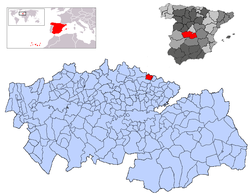Carranque | |
|---|---|
 | |
| Coordinates: 40°10′15″N3°53′49″W / 40.17083°N 3.89694°W | |
| Country | |
| Autonomous community | |
| Province | Toledo |
| Comarca | La Sagra |
| Judicial district | Illescas |
| Founded | Ver texto |
| Government | |
| • Alcalde | Alejandro Pompa de Mingo (2007) |
| Area | |
• Total | 25 km2 (10 sq mi) |
| Elevation | 665 m (2,182 ft) |
| Population (2024) [1] | |
• Total | 5,418 |
| • Density | 220/km2 (560/sq mi) |
| Demonym(s) | Carranqueño, ña |
| Time zone | UTC+1 (CET) |
| • Summer (DST) | UTC+2 (CEST) |
| Postal code | 45216 |
| Dialing code | 925 |
| Website | Official website |
Carranque is a town in the Toledo province, Castile-La Mancha, Spain. It is located in the area of the province bordering the province of Madrid called the Alta Sagra.



